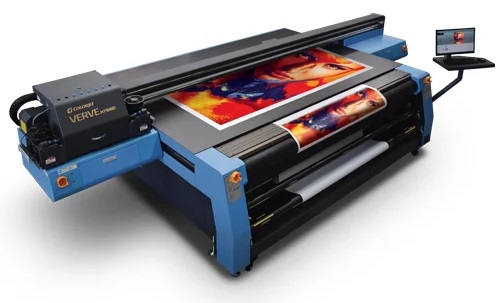What exactly is printing in UV?
Direct printing on objects is made easy with this ingenious method. UV printing is one of the most adaptable and fascinating direct-to-object printing technologies that has ever been developed, and the possibilities for its application are practically endless. The following are some of the advantages of UV printing:
quick production with instant ink curing, the capacity to print directly on various materials, and the flexibility to print three-dimensional textures, effects, and gloss highlights.
You may print bespoke designs, photos, text, and even textures directly onto various materials or items by utilizing UV printing technology. This allows for a lot of creative potentials.

How does the printing process use UV light?
UV digital printing is able to speed up the process of print manufacturing by instantaneously curing specially formulated UV inks on a wide variety of substrates using UV lamps. This allows the process to be performed on a much larger scale.
How good is UV printing?
However, the quality of the printed output is one of the most significant benefits that come with using UV printing. The inks do not have the opportunity to absorb or spread due to the UV printer’s incredibly fast drying time, which results in printing that is of a far higher quality.
Is UV printing the same as digital printing?
UV printing is a type of digital printing that makes use of ultraviolet lights to dry or cure ink as it is being printed. UV printing is also known as “light-curing” printing. The ink is quickly cured, or dried, by specially engineered UV lights that follow closely behind the printer as it spreads ink across the surface of a material (which is referred to as a “substrate”) during the printing process.
When the environmental impact is a concern
When compared to other kinds of ink, this one has a far lower rate of evaporation, which means there are fewer emissions of volatile organic compounds into the environment.
In UV printing, the curing of the ink is accomplished using a photomechanical process as opposed to drying via evaporation.

UV printing is a one-of-a-kind method of digital printing that makes use of ultraviolet (UV) light to dry or cure ink, adhesives, or coatings almost as soon as they make contact with the paper, or aluminum, foam board, or acrylic – in fact, as long as it fits in the printer, the technique can be used to print on almost anything. UV printing is also known as digital printing.
UV curing, also known as the photochemical drying process, was initially developed as a method for rapidly drying gel nail polishes that are used in manicures. However, in recent years, this method has been adopted by the printing industry, and it is now used to print on a wide variety of surfaces, including signage, brochures, and even beer bottles. The technique is exactly the same as conventional printing; the only differences are the types of inks and drying methods employed, as well as the improved quality of the finished items.
Solvent inks are employed in traditional printing methods; these inks have the potential to evaporate and create volatile organic compounds (VOCs), which are substances that are detrimental to the environment. In addition to producing heat and an associated odor, this method also makes use of them. In addition to this, it is necessary to use extra spray powders in order to assist in the process of ink offsetting and drying, which might take several days. Because the inks are absorbed into the printing medium, the colors may appear washed out and muted as a result. Because the printing technique can only be used on paper and card mediums, it cannot be used on materials such as plastic, glass, metal, foil, or acrylic as UV printing can. The printing process is largely limited to paper and card mediums.
In ultraviolet (UV) printing, mercury/quartz or LED lamps are used for curing instead of heat; the specifically designed high-intensity UV light closely follows as the unique ink is disseminated on the printing medium, drying it as soon as it is applied. This eliminates the need for a heating element. Because the ink goes from being a solid or paste to almost immediately becoming a liquid, there is no opportunity for it to evaporate, which means that no volatile organic compounds, toxic fumes, or ozone are released. As a result, the technology is friendly to the environment and has almost no carbon footprint at all.
A combination of liquid monomers, oligomers – polymers consisting of a small number of repeating units – and photoinitiators are found within the ink, adhesive, or coating. During the curing process, a high-intensity light in the ultraviolet part of the spectrum, with a wavelength between 200 and 400 nm, is absorbed by the photoinitiator. This causes the photoinitiator to undergo a chemical reaction known as chemical cross-linking, which causes the ink, coating, or adhesive to instantly become more rigid.

